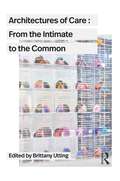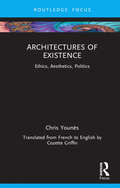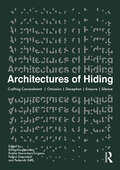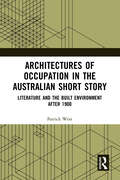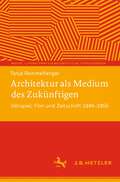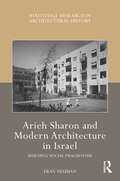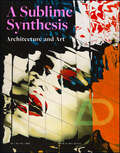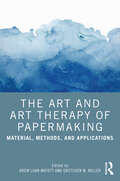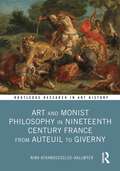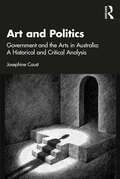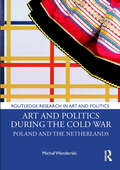- Table View
- List View
Architecture’s Disability Problem (Routledge Research in Architecture)
by Wanda Katja LiebermannArchitecture’s Disability Problem explores the intersection of architecture and disability in the United States from the perspective of professional practice. This book uncovers why, despite the profound effect of the Americans with Disabilities Act on the architectural profession, there has been so little interest in design for disability in mainstream architecture. To counter this, the book investigates alternative approaches to designing with disability, through three case studies. These showcase both buildings and how design processes driven by disabled people shape design and professional roles.Combining historical research, formal and discourse analysis, and interviews with people who design, construct, use buildings, and advocate for access, the book develops a social understanding of how the buildings work at functional, affective, and symbolic levels. Architecture’s Disability Problem is aimed at three primary readers: practicing architects, architectural scholars, and members of disability scholar-activist communities. Grounded in detailed design studies, the author hopes to unearth the social meaning-making of architecture related to disability. Ultimately, the book makes an argument for a focus on disability in its own right—as well as on the body—in place of the dominance of formal, object-oriented approaches.This book presents and argues for a fundamental shift in the way architectural education, policy, and practice views and engages with disability. It will be key reading for students, researchers, practitioners and policy-makers.
Architectures of Care: From the Intimate to the Common
Drawing from a diverse range of interdisciplinary voices, this book explores how spaces of care shape our affective, material, and social forms, from the most intimate scale of the body to our planetary commons.Typical definitions of care center around the maintenance of a livable life, encompassing everything from shelter and welfare to health and safety. Architecture plays a fundamental role in these definitions, inscribed in institutional archetypes such as the home, the hospital, the school, and the nursery. However, these spaces often structure modes of care that prescribe gender roles, bodily norms, and labor practices. How can architecture instead engage with an expanded definition of care that questions such roles and norms, producing more hybrid entanglements between our bodies, our collective lives, and our environments? Chapters in this book explore issues ranging from disabled domesticities and nursing, unbuilding whiteness in the built environment, practices and pedagogies of environmental care, and the solidarity networks within ‘The Cloud’. Case studies include Floating University Berlin, commoning initiatives by the Black Panther party, and hospitals for the United Mine Workers of America, among many other sites and scales of care.Exploring architecture through the lenses of gender studies, labor theory, environmental justice, and the medical humanities, this book will engage students and academics from a wide range of disciplines.
Architectures of Care: From the Intimate to the Common
by Brittany UttingDrawing from a diverse range of interdisciplinary voices, this book explores how spaces of care shape our affective, material, and social forms, from the most intimate scale of the body to our planetary commons.Typical definitions of care center around the maintenance of a livable life, encompassing everything from shelter and welfare to health and safety. Architecture plays a fundamental role in these definitions, inscribed in institutional archetypes such as the home, the hospital, the school, and the nursery. However, these spaces often structure modes of care that prescribe gender roles, bodily norms, and labor practices. How can architecture instead engage with an expanded definition of care that questions such roles and norms, producing more hybrid entanglements between our bodies, our collective lives, and our environments? Chapters in this book explore issues ranging from disabled domesticities and nursing, unbuilding whiteness in the built environment, practices and pedagogies of environmental care, and the solidarity networks within ‘The Cloud’. Case studies include Floating University Berlin, commoning initiatives by the Black Panther party, and hospitals for the United Mine Workers of America, among many other sites and scales of care.Exploring architecture through the lenses of gender studies, labor theory, environmental justice, and the medical humanities, this book will engage students and academics from a wide range of disciplines.
Architectures of Existence: Ethics, Aesthetics, Politics
by Chris YounèsArchitectures of Existence proposes that philosophical thinking (ecosophical thinking) can inform the way we engage with our world and its inhabitants, as architects, designers and planners, but also as individuals, as people, and as a society. In Art et existence, Maldiney states: "For us, to inhabit is to exist". This book aims to unfold, extend, articulate and thicken this postulate by interweaving architecture, city, landscape, literature and philosophy. It takes up the synergistic lines of long-term research carried out from an ecosophical perspective. Such an attitude explores an art of existing in multiplicity, singularity and openness, manifesting the critical dimension through a reinterpretation of the knotting of the trajectories of time, humanity and its becoming. Insisting on what is between things and beings as well as on what is happening, regenerating, recycling, reviving, saving, diversifying, sparing, recreating, meditating: and so caring. These are all eco-rhythms of a different type between human and non-human, to consider ourselves in the world. In an era of uncertainty and climate threats, this book develops the margins of possibility offered by the subject of architecture. This book will be of interest to researchers and students of architecture, urban planning and philosophy.
Architectures of Existence: Ethics, Aesthetics, Politics
by Chris YounèsArchitectures of Existence proposes that philosophical thinking (ecosophical thinking) can inform the way we engage with our world and its inhabitants, as architects, designers and planners, but also as individuals, as people, and as a society. In Art et existence, Maldiney states: "For us, to inhabit is to exist". This book aims to unfold, extend, articulate and thicken this postulate by interweaving architecture, city, landscape, literature and philosophy. It takes up the synergistic lines of long-term research carried out from an ecosophical perspective. Such an attitude explores an art of existing in multiplicity, singularity and openness, manifesting the critical dimension through a reinterpretation of the knotting of the trajectories of time, humanity and its becoming. Insisting on what is between things and beings as well as on what is happening, regenerating, recycling, reviving, saving, diversifying, sparing, recreating, meditating: and so caring. These are all eco-rhythms of a different type between human and non-human, to consider ourselves in the world. In an era of uncertainty and climate threats, this book develops the margins of possibility offered by the subject of architecture. This book will be of interest to researchers and students of architecture, urban planning and philosophy.
Architectures of Hiding: Crafting Concealment | Omission | Deception | Erasure | Silence
Architecture manifests as a space of concealment and unconcealment, lethe and alêtheia, enclosure and disclosure, where its making and agency are both hidden and revealed. With an urgency to amplify narratives that are overlooked, silenced and unacknowledged in and by architectural spaces, histories and theories, this book contends the need for a critical study of hiding in the context of architectural processes. It urges the understanding of inherent opportunities, power structures and covert strategies, whether socio-cultural, geo-political, environmental or economic, as they are related to their hidescapes – the constructed landscapes of our built environments participating in the architectures of hiding. Looking at and beyond the intentions and agency that architects possess, architectural spaces lend themselves as apparatuses for various forms of hiding and un(hiding). The examples explored in this book and the creative works presented in the interviews enclosed in the interludes of this publication cover a broad range of geographic and cultural contexts, discursively disclosing hidden aspects of architectural meaning. The book investigates the imaginative intrigue of concealing and revealing in design processes, along with moral responsibilities and ethical dilemmas inherent in crafting concealment through the making and reception of architecture.
Architectures of Hiding: Crafting Concealment | Omission | Deception | Erasure | Silence
by Rana Abughannam Émélie Desrochers-Turgeon Pallavi Swaranjali Federica GoffiArchitecture manifests as a space of concealment and unconcealment, lethe and alêtheia, enclosure and disclosure, where its making and agency are both hidden and revealed. With an urgency to amplify narratives that are overlooked, silenced and unacknowledged in and by architectural spaces, histories and theories, this book contends the need for a critical study of hiding in the context of architectural processes. It urges the understanding of inherent opportunities, power structures and covert strategies, whether socio-cultural, geo-political, environmental or economic, as they are related to their hidescapes – the constructed landscapes of our built environments participating in the architectures of hiding. Looking at and beyond the intentions and agency that architects possess, architectural spaces lend themselves as apparatuses for various forms of hiding and un(hiding). The examples explored in this book and the creative works presented in the interviews enclosed in the interludes of this publication cover a broad range of geographic and cultural contexts, discursively disclosing hidden aspects of architectural meaning. The book investigates the imaginative intrigue of concealing and revealing in design processes, along with moral responsibilities and ethical dilemmas inherent in crafting concealment through the making and reception of architecture.
Architectures of Occupation in the Australian Short Story: Literature and the Built Environment after 1900
by Patrick WestPatrick West’s Architectures of Occupation in the Australian Short Story cultivates the potential for literary representations of architectural space to contribute to the development of a contemporary politics of Australian post-colonialism.West argues that the predominance of tropes of place within cultural and critical expressions of Australian post-colonialism should be re-balanced through attention to spatial strategies of anti-colonial power. To elaborate the raw material of such strategies, West develops interdisciplinary close readings of keynote stories within three female-authored, pan-twentieth century, Australian short-story collections: Bush Studies by Barbara Baynton (1902); Kiss on the Lips and Other Stories by Katharine Susannah Prichard (1932); and White Turtle: A Collection of Short Stories by Merlinda Bobis (1999). The capacity of the short-story form to prompt creative and politically germinal engagements with species of space associated with architecture and buildings is underscored. Relatedly, West argues that the recent resurgence of binary thought—on local, national, and international scales—occasions an approach to the short-story collections shaped by binary relationships like a dichotomy of inside and outside. Concluding his argument, West connects the literary and architectural critiques of the story collections to the wicked problem, linked to ongoing colonial violences, of improving Australian Indigenous housing outcomes.Innovative and interdisciplinary, this book will be of interest to scholars and students of Literary, Architectural, and Postcolonial Studies. .
Architectures of Occupation in the Australian Short Story: Literature and the Built Environment after 1900
by Patrick WestPatrick West’s Architectures of Occupation in the Australian Short Story cultivates the potential for literary representations of architectural space to contribute to the development of a contemporary politics of Australian post-colonialism.West argues that the predominance of tropes of place within cultural and critical expressions of Australian post-colonialism should be re-balanced through attention to spatial strategies of anti-colonial power. To elaborate the raw material of such strategies, West develops interdisciplinary close readings of keynote stories within three female-authored, pan-twentieth century, Australian short-story collections: Bush Studies by Barbara Baynton (1902); Kiss on the Lips and Other Stories by Katharine Susannah Prichard (1932); and White Turtle: A Collection of Short Stories by Merlinda Bobis (1999). The capacity of the short-story form to prompt creative and politically germinal engagements with species of space associated with architecture and buildings is underscored. Relatedly, West argues that the recent resurgence of binary thought—on local, national, and international scales—occasions an approach to the short-story collections shaped by binary relationships like a dichotomy of inside and outside. Concluding his argument, West connects the literary and architectural critiques of the story collections to the wicked problem, linked to ongoing colonial violences, of improving Australian Indigenous housing outcomes.Innovative and interdisciplinary, this book will be of interest to scholars and students of Literary, Architectural, and Postcolonial Studies. .
Architektur als Medium des Zukünftigen: Hörspiel, Film und Zeitschrift 1945–1955 (Media. Literaturwissenschaftliche Forschungen)
by Tanja RommelfangerDas Buch beschäftigt sich mit der Architektur der unmittelbaren Nachkriegszeit als Gegenstand medialer Repräsentation. Dabei bewegt es sich im Spannungsfeld von Germanistik, Architekturgeschichte und Medienwissenschaft. Anhand von Radiohörspielen, Architekturzeitschriften und Filmen geht es der Frage nach, wie Architektur in Szene gesetzt wird. Dabei bezieht die Analyse mit ein, wie diese im Hinblick auf die Konstruktion und den Aufbau einer neuen Zukunft mit bestehenden Diskursen der Moderne in Verbindung gebracht wird und problematische Bezüge zur nationalsozialistischen Vergangenheit aufweist. In Werken von Günter Eich (Träume, 1951), Otto Renner (BAU. Zeitschrift für wohnen, arbeiten, sich erholen, 1947) und mit einem anonymen Städtefilm (Stein auf Stein. Ein Land baut auf, 1949) werden wenig bekannte Kurzformen aufgegriffen, um deren Verknüpfung mit neuen Medienverbunden und soziopolitischen Diskursen zu erforschen. Die detaillierten Analysen - von Eichs „Fünftem Traum“ als Mediengeflecht von Text, Musik und Geräusch, der heute wenig bekannten, aber zu ihrer Zeit renommierten Architekturzeitschrift BAU als Medienverbund aus zirkulierenden und wiederaufbereiteten Fotografien, Zeichnungen, Texten und Typografie und dem Kurzfilm Stein auf Stein mit seinen intermedialen Bezügen u.a. zur Fotografie - stellen Querverbindungen zu vielen Figuren und Werken dieser Zeit her, in der die Architektur eine Neubewertung als vermittelnde Instanz zwischen Individuum und Gesellschaft erfährt.Davon ausgehend schließt die Autorin auf größere Problematiken, die die Öffentlichkeit in den frühen Nachkriegsjahren beschäftigten. Dabei weist sie Momente des Exzesses und der Überschreitung in den Werken auf, die in einer Zeit der Ressourcenknappheit, Medienregulierung und konfliktreicher Lizensierungspolitik entstanden sind. Auch der Umbruch im Mediengefüge durch die Einführung von Fernsehen und die moralisch aufgeladene Debatte über eine entnazifizierte Öffentlichkeit werden reflektiert. Das Buch geht auch ausführlich auf die Besatzungspolitik im teilautonomen Saarland ein und führt die französische Kolonialpolitik in Algerien indirekt über die Rezeption Le Corbusiers in den deutschen Diskurs ein.Das Buch richtet sich an Studierende und Forschende der Fachgebiete Literatur-, Medien- und Kulturwissenschaft, Kunstgeschichte und Architektur.
Architekturleistungen des Späthistorismus: Nachblüte der Stilbaukunst um 1900 (Architekturen #77)
by Christian RablKaum ein Architekturphänomen ist dermaßen mit Diskredit behaftet wie der Späthistorismus, dessen künstlerische Gelingensbedingungen durch den Kulturumbruch des Fin de Siècle delegitimiert scheinen. Auch wenn die Stilbaukunst um und nach 1900 das bürgerlich-kapitalistische Zeitalter repräsentierte, so lassen sich darunter innovative Ansätze und eklektizistische Weiterschöpfungen ausmachen. Christian Rabl systematisiert diese stilarchitektonischen Fortschritte in ihren Einzelphänomenen - unter anderem an den späthistoristischen Stadtästhetiken von Madrid, Bukarest, Riga, Barcelona und Karlsbad.
Arieh Sharon and Modern Architecture in Israel: Building Social Pragmatism (Routledge Research in Architectural History)
by Eran NeumanArieh Sharon and Modern Architecture in Israel: Building Social Pragmatism offers the first comprehensive survey of the work of Arieh Sharon and analyzes and discusses his designs and plans in relation to the emergence of the State of Israel. A graduate of the Bauhaus, Sharon worked for a few years at the office of Hannes Mayer before returning to Mandatory Palestine. There, he established his office which was occupied in its first years in planning kibbutzim and residential buildings in Tel Aviv. After the establishment of the State of Israel in 1948, Arieh Sharon became the director and chief architect of the National Planning Department, where he was asked to devise the young country’s first national masterplan. Known as the Sharon Plan, it was instrumental in shaping the development of the new nation. During the 1950s and 1960s, Sharon designed many of Israel’s institutions, including hospitals and buildings on university campuses. This book presents Sharon’s exceptionally wide range of work and examines his perception of architecture in both socialist and pragmatist terms. It also explores Sharon’s modernist approach to architecture and his subsequent shift to Brutalist architecture, when he partnered with Benjamin Idelson in the 1950s and when his son, Eldar Sharon, joined the office in 1964. Thus, the book contributes a missing chapter in the historiography of Israeli architecture in particular and of modern architecture overall. This book will be of interest to researchers in architecture, modern architecture, Israel studies, Middle Eastern studies and migration of knowledge.
Arieh Sharon and Modern Architecture in Israel: Building Social Pragmatism (Routledge Research in Architectural History)
by Eran NeumanArieh Sharon and Modern Architecture in Israel: Building Social Pragmatism offers the first comprehensive survey of the work of Arieh Sharon and analyzes and discusses his designs and plans in relation to the emergence of the State of Israel. A graduate of the Bauhaus, Sharon worked for a few years at the office of Hannes Mayer before returning to Mandatory Palestine. There, he established his office which was occupied in its first years in planning kibbutzim and residential buildings in Tel Aviv. After the establishment of the State of Israel in 1948, Arieh Sharon became the director and chief architect of the National Planning Department, where he was asked to devise the young country’s first national masterplan. Known as the Sharon Plan, it was instrumental in shaping the development of the new nation. During the 1950s and 1960s, Sharon designed many of Israel’s institutions, including hospitals and buildings on university campuses. This book presents Sharon’s exceptionally wide range of work and examines his perception of architecture in both socialist and pragmatist terms. It also explores Sharon’s modernist approach to architecture and his subsequent shift to Brutalist architecture, when he partnered with Benjamin Idelson in the 1950s and when his son, Eldar Sharon, joined the office in 1964. Thus, the book contributes a missing chapter in the historiography of Israeli architecture in particular and of modern architecture overall. This book will be of interest to researchers in architecture, modern architecture, Israel studies, Middle Eastern studies and migration of knowledge.
Art and Architecture: A Sublime Synthesis (Architectural Design)
The link between architecture and art and the sublimity it can create has a history that stretches back millennia. From cave paintings to the stained glass and saintly icons in churches and cathedrals, to the geometric and calligraphic treatments of mosques and contemporary artists channelling architecture and vice versa, and so much else. This AD is about the contemporary interactions between living artists and architects, and the artistic practices, such as poetry and abstractions, that architects adopt to develop ideas for their projects. The issue features artists, architects, curators, musicians, poets and designer craftspeople, illustrating the current rich mix of architectonic constructions, interventions and set pieces that range from musical performance to exhibition designs, glass works and digital 3D scanning. It lays out the wide spectrum and beauty of these sublime correspondences, with contributions from architects about their own artistic practices, and creative works viewed through the eyes of architectural commentators. An explosion of colour, form and creative tactics for making multifaceted work that above all is architectural, it offers a cornucopia of possibilities. Contributors: Peter Baldwin, Kathy Battista, Nic Clear, Mathew Emmett, Paul Finch, Paul Greenhalgh, Hamed Khosravi, Eva Menuhin, Felix Robbins, and Simon Withers. Featured architects and artists: a-project, Captivate, Brian Clarke, Andy Goldsworthy, Barbara Hepworth, Danny Lane, Ben Johnson, Brendan Neiland, Ian Ritchie, and Zoe Zenghelis.
The Art and Art Therapy of Papermaking: Material, Methods, and Applications
by Drew Luan Matott Gretchen M. MillerThe Art and Art Therapy of Papermaking: Material, Methods, and Applications provides a comprehensive collection about the contemporary practices, media, and value of hand papermaking as social engagement, art therapy, and personal voice. Divided into three parts that highlight each of these areas, contributors explore topics such as advocacy, work with survivors, community outreach, medical challenges, and how papermaking can empower creative expression, stories of change, recovery, and reclamation to address trauma, grief and loss, social action, and life experiences. Previous books have covered hand papermaking or art therapy media as stand-alone subjects; this text is the first of its kind that unites and describes the convergence of papermaking in all these forms. Art therapists, art educators, and artists will find this book essential to their education about how papermaking can be a powerful process to make meaning for the self, groups, and community.
The Art and Art Therapy of Papermaking: Material, Methods, and Applications
The Art and Art Therapy of Papermaking: Material, Methods, and Applications provides a comprehensive collection about the contemporary practices, media, and value of hand papermaking as social engagement, art therapy, and personal voice. Divided into three parts that highlight each of these areas, contributors explore topics such as advocacy, work with survivors, community outreach, medical challenges, and how papermaking can empower creative expression, stories of change, recovery, and reclamation to address trauma, grief and loss, social action, and life experiences. Previous books have covered hand papermaking or art therapy media as stand-alone subjects; this text is the first of its kind that unites and describes the convergence of papermaking in all these forms. Art therapists, art educators, and artists will find this book essential to their education about how papermaking can be a powerful process to make meaning for the self, groups, and community.
Art and Biotechnology: Viral Culture from CRISPR to COVID (Biotechne: Interthinking Art, Science and Design)
by Claire Correo Nettleton and Louise MackenzieThis interdisciplinary anthology examines the relationship between developments in biotechnology and both artistic and literary innovation, focussing in particular on how newfound molecular technologies and knowledge regimes, such as CRISPR gene editing, alter conceptions of what it means to be human.The book presents 21 essays, split across four parts, from a coterie of artists, theorists, historians and scientists which examine the symbiotic relationship between humans, animals, and viruses as well as the impossibility of germ-free existence.The essays in this volume are urgent in their topicality, embodying the exhilarating yet alarming zeitgeist of contemporary nonhuman-to-human viral transmission and gene editing technologies. Ultimately, Art and Biotechnology reveals how art and biotechnology influence each other and how art has shaped the discussion around gene editing and the socio-cultural aspects of the Covid-19 pandemic. It is essential reading for students and researchers focussing on science and art, environmental humanities, and ethics.
Art and Modernism in Socialist China: Unexplored International Encounters 1949–1979 (Routledge Research in Art History)
This edited volume will be the first book examining the art history of China’s socialist period from the perspective of modernism, modernity, and global interactions.The majority of chapters are based on newly available archival materials and fresh critical frameworks/concepts. By shifting the frame of interpretation from socialist realism to socialist modernity, this study reveals the plurality of the historical process of developing modernity in China, the autonomy of artistic agency, and the complexity of an art world conditioned, yet not completely confined, by its surrounding political and ideological apparatus. The unexpected global exchanges examined by many of the authors in this study and the divergent approaches, topics, and genres they present add new sources and insights to this research field, revealing an art history that is heterogeneous, pluralistic, and multi-layered.The book will be of interest to scholars working in art history, art and politics, and Chinese studies.
Art and Modernism in Socialist China: Unexplored International Encounters 1949–1979 (Routledge Research in Art History)
by Shuyu Kong Julia F. Andrews Shengtian ZhengThis edited volume will be the first book examining the art history of China’s socialist period from the perspective of modernism, modernity, and global interactions.The majority of chapters are based on newly available archival materials and fresh critical frameworks/concepts. By shifting the frame of interpretation from socialist realism to socialist modernity, this study reveals the plurality of the historical process of developing modernity in China, the autonomy of artistic agency, and the complexity of an art world conditioned, yet not completely confined, by its surrounding political and ideological apparatus. The unexpected global exchanges examined by many of the authors in this study and the divergent approaches, topics, and genres they present add new sources and insights to this research field, revealing an art history that is heterogeneous, pluralistic, and multi-layered.The book will be of interest to scholars working in art history, art and politics, and Chinese studies.
Art and Monist Philosophy in Nineteenth Century France From Auteuil to Giverny (Routledge Research in Art History)
by Nina Athanassoglou-KallmyerThis is a study of the relation between the fine arts and philosophy in France, from the aftermath of the 1789 revolution to the end of the nineteenth century, when a philosophy of being called “Monism” emerged and became increasingly popular among intellectuals, artists and scientists. Nina Athanassoglou-Kallmyer traces the evolution and impact of this monist thought and its various permutations as a transformative force on certain aspects of French art and culture – from Romanticism to Impressionism – and as a theoretical backdrop that paved the way to as yet unexplored aspects of a modernist aesthetic. Chapters concentrate on three major artists, Théodore Géricault (1791–1824), Eugène Delacroix (1798–1863) and Claude Monet (1840–1926), and their particular approach to and interpretation of this unitarian concept. The book will be of interest to scholars working in art history, philosophy and cultural history.
Art and Monist Philosophy in Nineteenth Century France From Auteuil to Giverny (Routledge Research in Art History)
by Nina Athanassoglou-KallmyerThis is a study of the relation between the fine arts and philosophy in France, from the aftermath of the 1789 revolution to the end of the nineteenth century, when a philosophy of being called “Monism” emerged and became increasingly popular among intellectuals, artists and scientists. Nina Athanassoglou-Kallmyer traces the evolution and impact of this monist thought and its various permutations as a transformative force on certain aspects of French art and culture – from Romanticism to Impressionism – and as a theoretical backdrop that paved the way to as yet unexplored aspects of a modernist aesthetic. Chapters concentrate on three major artists, Théodore Géricault (1791–1824), Eugène Delacroix (1798–1863) and Claude Monet (1840–1926), and their particular approach to and interpretation of this unitarian concept. The book will be of interest to scholars working in art history, philosophy and cultural history.
The Art and Philosophy of the Garden
by David Fenner Ethan FennerThe Art and Philosophy of the Garden offers the first authoritative and comprehensive philosophical discussion of the aesthetics of gardens. Philosopher David Fenner and horticulturist Ethan Fenner address such questions as: what is a garden? Are some gardens works of art? What does it mean to appreciate gardens aesthetically? Given that gardens are always changing in a variety of ways, how is it possible to compare, evaluate, or find meaning in them? How can we interpret gardens? How do we value gardens and gardening? While grounded in Western thought, Fenner and Fenner bring to bear global ideas and examples of gardens and gardening techniques. Inspired by a surge of philosophical interest in gardening, Fenner and Fenner argue that some gardens are indeed works of art. They explore how we might understand the aesthetic properties of gardens, and focus on what it means to "read" the formal aspects of gardens -- what the authors call "garden form" -- as a basis for interpreting a garden. They discuss the intersection of gardens/gardening and value: questions such as what sort of value gardens possess; whether and how ethics are relevant to gardens; how gardens may be evaluated and compared; and the value of the practice of gardening. This comprehensive philosophical discussion on the aesthetics of gardens and gardening will not only interest those concerned with garden theory but will interest any thoughtful and intellectually curious gardener.
Art and Politics: Government and the Arts in Australia: A Historical and Critical Analysis
by Josephine CaustAustralian governments at all levels have been engaged with arts and culture in many different forms since the beginning of European settlement. The way this has occurred is documented and analysed here, both from an historical and critical perspective. Changing understandings of culture and the significance of Indigenous Culture to Australia receive special attention. While the focus is primarily directed to Federal Government engagement, there is also consideration paid to both state and local government involvement. There is attention paid to the censorship of arts practice by governments as well as the direct interventions by politicians in arts practice. Different approaches to the arts by governments are also considered, as well as attempts to develop a national cultural policy. The impact of the recent pandemic is addressed and various research reports about the arts sector and its relationship with government are also noted. There is then a final discussion about some issues that governments could address in the future, that might ensure a more sustainable Australian arts sector. This book will be of particular interest to scholars of contemporary arts, arts management, cultural history, public policy and cultural policy. It may also interest bureaucrats and politicians.
Art and Politics: Government and the Arts in Australia: A Historical and Critical Analysis
by Josephine CaustAustralian governments at all levels have been engaged with arts and culture in many different forms since the beginning of European settlement. The way this has occurred is documented and analysed here, both from an historical and critical perspective. Changing understandings of culture and the significance of Indigenous Culture to Australia receive special attention. While the focus is primarily directed to Federal Government engagement, there is also consideration paid to both state and local government involvement. There is attention paid to the censorship of arts practice by governments as well as the direct interventions by politicians in arts practice. Different approaches to the arts by governments are also considered, as well as attempts to develop a national cultural policy. The impact of the recent pandemic is addressed and various research reports about the arts sector and its relationship with government are also noted. There is then a final discussion about some issues that governments could address in the future, that might ensure a more sustainable Australian arts sector. This book will be of particular interest to scholars of contemporary arts, arts management, cultural history, public policy and cultural policy. It may also interest bureaucrats and politicians.
Art and Politics During the Cold War: Poland and the Netherlands (Routledge Research in Art and Politics)
by Michał WenderskiDrawing on thousands of historical documents from Polish and Dutch archives, this book explores Cold War cultural exchange between so-called ‘smaller powers’ of this global conflict, which thus far has been predominately explored from the perspective of the two superpowers or more pivotal countries. By looking at how cultural, artistic and scholarly relations were developed between Poland and the Netherlands, Michał Wenderski sheds new light on the history of the Cultural Cold War that was not always orchestrated solely by its main players. Less pivotal states – for example, Poland and the Netherlands – likewise intentionally created their international cultural policies and shaped their cultural exchange with countries from the other side of the Iron Curtain. This study reconstructs these policies and identifies the varying factors that influenced them – both official and less formal. The book will be of interest to scholars working in art history, history of the Cold War, post-war European history, international cultural relations, Dutch studies and Polish studies.

